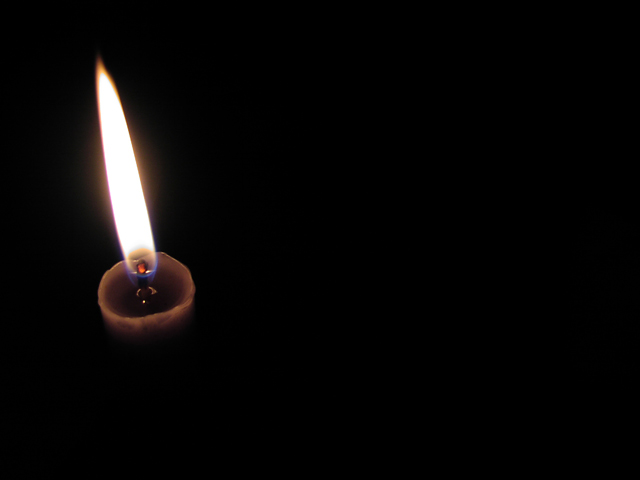During the summer I went to an estate sale where I found, among other things, a vintage globe, for next to nothing. I bought it, not entirely sure why. It sits in my living room, as there are not many other places it will fit in my place. One day, feeling down, I happened to look up at the globe, and Africa was staring back at me. It doesn't take much to know that I am luckier than most people in Africa right now and at that moment, looking at the globe, I felt very foolish feeling any sorrow for myself. I am extremely fortunate next to most people on Earth.
In December I always like to think of a way to make a difference for someone less fortunate, and with my globe in mind, I am so happy to have discovered Women for Women International. I'm so impressed with their hands-on work to help women (and through women, all of society) in war-ravaged parts of the world. Please read my holiday message about this great organization and my reasons for wanting to help.
All through the month I will be offering a number of items in my eBay store and auctions with 100% of the final sale price going to Women for Women International. I would be so glad if you would come check out my offerings at denisebrain.
Popular Posts
-
Every week, the Vintage Fashion Guild has a fashion parade, where trade members show off their finds suited to the week's theme. I'm...
-
I think I may have seen one or two Avengers episodes as a child, and I remember how funny, bright and eccentric everything seemed. Fast for...
-
According to the Feeding America site, the contribution I was able to make yesterday will translate into 1172 meals for hungry Americans.
-
BUSINESS Although high fashion magazines didn't dwell on business fashion (some would call it anti-fashion), they couldn't complete...
-
With so much focus on the sad event that took place 100 years ago, I thought I'd mention a few of the other events of 1912—specifically ...
-
I consider runway fashion to be in the (no pun...) running for future vintage, and here are some of my favorites from fall 2011 runways. It ...
-
Kelly Bundy with short hair/bob, red-red cropped top and 1990s jeans ;) 90s floral dress with split Black crop top and red-red skirt 90s cro...
-
One most excellent (and, I might add, hopeful) definition of elegance comes from Geneviève Antoine Dariaux at the start of her book Elegance...
-
If you know me at all, you know I am very concerned for endangered species, probably none more than the manatee. Manatees are gentle aquatic...
Thinking about how lucky I am...
Thoughts on modeling
A couple of early modeling efforts: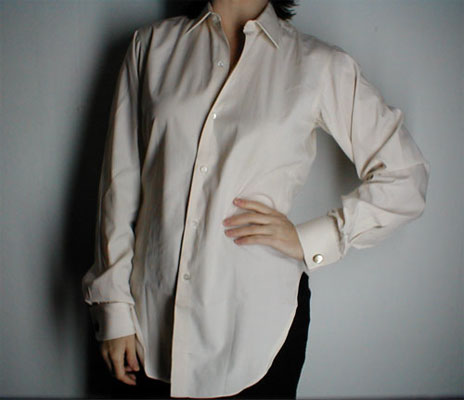
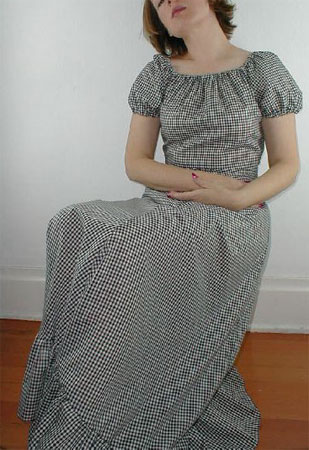
After awhile I started to be known for doing my own modeling and I am still the same non-model in terms of age, size and looks! Oh, actually I'm even older! However, I am gaining experience. When someone says to me that she knows someone who is "very cute and would make a great model" I feel skeptical until I see her "act" because to me it is all about acting a part. I do smile in real life, but nothing like the unrelenting joy I often portray in photos. This isn't real life after all, but a glorified fragment of a better, perhaps imagined past. I love old fashion magazines, with their intriguing photography and modeling, not to mention the clothing. I want to convey the flavor of the happy, healthy look you often find in vintage fashion spreads.
Once someone posted a message about me, that I "invite everyone else in for the fun, instead of trying to be cooler than [my] buyers." Nothing could make me happier than that statement, because I only want others to feel they could enjoy the clothing as much as I do!
A couple of recent photos:
Concerning the fiber content of a fabric
There are a number of tests, some along the lines of folklore (dampening and creasing a fabric to see how it behaves) and some more scientific (exposing a fabric to certain chemicals and examining it under a microscope), but by far the most accessible test is burning.
One web offering, Ditzy Prints Fiber Burn Chart is a great resource. You should know that burning fibers takes practice, and you must start with a little caution. You should burn over a sink or bucket so that if you get what seems like a fabric inferno you can ditch! Most necessary is a tweezers to hold the little fabric swatch, and a lighter. If you burn matches of any sort you will pick up the scent of burning paper or wood, throwing you off for discerning the burning fabric's odor.
If you are really serious about learning how a fiber burns, I recommend taking known fabric samples and examining how they smell and behave while burning, and look, feel and smell once burned.
Many fabrics are blends and will have characteristics of more than one fiber when burned. If you are lucky, the fibers are distinct in the fabric, so that you can separate the weft from the warp and discover the content of each fiber.
One giveaway is acetate, which is the only fiber that dissolves when dampened with acetone (i.e. nail polish remover).
To do a burn test, do your best to find as big a swatch as possible without damaging or conspicuous loss to a garment. Even a few threads are "readable" once you get good at this, but a piece of about 1" X 1/4" is a minimum necessity if you are just getting started. Hold one end of the fabric with the tweezers and expose the other end to the flame of a lighter. Notice if the fabric readily burns or takes some effort to light. Also, note if the fire burns out or continues until all the fabric is burned. Smell the burning fabric.
Then, once the fire is out, notice whether the remains are black or grey, and feel to decide if is harder (bead-like) or soft (ash-like). On the fiber burn chart all these elements will help you narrow the choices.
Your senses also will help determine a fabric's fiber content without burning, given a chance to learn. With experience a silk, wool, rayon, polyester or acetate are discernible just by look and feel...but the details of their look and feel are so much harder to describe online.
I wish everyone who cared to learn about fabrics could have a mentor lead them. From what little I know, a knowledgeable person and a guided experience with fabrics makes a very complex project so much easier and memorable. If you have a chance, be taught first hand!
My "first impression" concept for ID-ing fabrics
I have a long way to go, but I have positively identified examples of most of these fabrics, and I mean to grow the list and swatch samples. I hope that even the descriptions help others.
NETS
Illusion - Very fine, sheer net
Point d'esprit - Net with dots scattered all over
Tulle - Fine net with a hexagonal mesh.
LIGHTEST, OPEN WEAVE OR SHEER FABRICS
Crepe de chine - Plain weave with fine crepe effect
Gauze - Thin, sheer open weave of plain or leno weave
Georgette - Sheer plain weave with a fine crepe surface
Handkerchief linen - Sheer linen
Mousseline - Broad classification of lightweight, sheer crisp fabrics
Organdy - Sheer, plain weave stiffened lawn
Organza - Transparent, crisp plain weave
Voile - Sheer plain weave with crisp, wiry hand
FINE, LIGHT FABRICS
Batiste - Plain weave, with subtle lengthwise streaks
Cambric - Soft plain weave, slight luster
Challis - Soft plain weave, often printed w/ small florals
Charmeuse - Soft, drapey, smooth, semi-lustrous satin face, dull back
Crepe-back satin - Reversible satin weave, smooth & lustrous on one side, crepe on other
Gabardine - Twill weave w/ distinct rib
Lawn -Fine, plain weave, relatively sheer. Close construction
Percale - Plain weave, firm, balanced construction
Sateen - Cotton in satin weave
Surah - Silk or silky manufactured fabric in twill weave. Soft, lustrous
COARSER, HEAVIER FABRICS
Buckram - Plain weave, coarse, open, heavily sized, used as a stiffener interfacing
Cavalry twill - Strong, rugged, pronounced double twill at 63° angle
Cheviot - Hairy nap wool or worsted, rough surface, fulled. Plain or twill weaves
Chino - Twilled mercerized cotton
Denim - Right-hand twill weave, colored warp, white filling (compare to drill)
Drill - Resembles denim, but left-hand twill
Duck - Plain weave, light canvas
Homespun - Plain weave, course, uneven yarns, similar to tweed
Hopsacking - Same as burlap. Basket weave, coarse, loosely woven
Lodencloth - Coarse wool coating fabric woven in the Tyrols w/ natural water repellancy
Melton - Plain weave, completely smooth, short nap, at least partly wool
Muslin - Firm, plain weave cotton; broad category from sheer to heavyweight
Serge - Most commonly twilled worsted suiting dyed navy blue
Whipcord - Twilled rugged fabric w/ wiry hand
PILES AND TREATED FABRICS
Burn-out fabric - Made w/ 2 different yarns w/ pattern made by destroying one of the yarns in a printing process which uses chemicals instead of color.
Crushed velvet - Velvet processed to have irregular surface
Panne velvet - Flattened pile velvet
Plush - Surface longer than velvet, less closely woven
Velvet - Short cut warp pile fabric
PATTERNED OR PUCKERED TEXTURED FABRICS
Crepe - Wrinkled or grained surface effect
Embossed fabric - Raised design made by passing cloth through hot, engraved rollers
Matelassé - Puckered, quilted, waded effect
Plissé - Puckered stripes made by applying caustic soda
Seersucker - Puckered stripes made by weaving tension variations
SLUBBY TEXTURED FABRICS
Butcher cloth - Linen like, strong, heavy, plain weave
Donegal tweed - Plain or twill weave medium to heavy wool with colored slubbing
Doupioni silk - Irregular, rough silk reeled from double cocoons
Pongee - Plain weave, light to medium-weight irregular silk, often natural ecru color
Shantung - Rough, plain weave silk, heavier than pongee
VERY TEXTURED FABRICS
Bouclé - Woven or knit fabric using rough, curly, knotted, fancy yarn
Ratiné - Plain weave, loosely constructed fabric using curly, knotty fancy ratiné yarn
HORIZONTALLY RIBBED FABRICS
Bengaline - Plain weave, filling courser than warp, but more warp yarns used, covering picks
Broadcloth - Unbalanced plain weave, finer rib than poplin
Faille - Plain weave, like grosgrain only flatter rib
Grosgrain - Firm, closely woven plain weave ribbed fabric or ribbon
Ottoman - Plain weave, cords larger & rounder than faille or bengaline
Poplin - Subtle but noticeable rib warp plain weave fabric, more rib than broadcloath
Rep - Plain weave, close spaced narrow ribs, less than bengaline, more than poplin
Taffeta - Broad category of plain weave, fine, smooth, crisp fabrics, usually w/ fine cross rib
VERTICALLY RIBBED FABRICS
Bedford cord - Heavy, plain weave corded fabric
Corduroy - Pile ribbed
Pinwale corduroy - Finely ribbed
Piqué - Light bedford cord, or also in fancy patterns (i.e. bird..s eye)
FABRICS WITH SPECIAL FINISHES
Brushed fabric - Softened feel from wire brushing process
Chintz - Plain weave cotton or cotton blend w/ glaze treatment
Flannel - Light to medium weight plain or twill weave fabric, slightly napped
Moiré - ..Watered.. finishing process, usually applied to ribbed fabric
Polished cotton - Luster from satin weave, or smoothing roller finish
Suede cloth - Woven or knit fabric finished to resemble suede
Sueded silk - Soft nap finish silk
PRINTED PATTERN FABRICS
Calico - Plain weave cotton or blend with small, busy, printed pattern
Foulard - Lustrous twill w/ small printed design on plain ground
Toile de jouy - Floral or scenic designs, classic motifs finely detailed
WOVEN PATTERN FABRICS
Brocade - Rich, heavy jacquard-woven fabric w/ raised patterns emphasized by contrasting surfaces or colors (see jacquard, damask)
Chambray - Plain weave w/ colored warp, white filling
Damask - Similar to brocade, but flatter
Dobby weave - Specific, small, geometric figures in fabric woven w/ dobby loom
Gingham - Plain weave, even check plaid
Heather effect - Vari-colored effect from blended woolen yarns, often greens, browns
Houndstooth check - Twill woven in characteristic pattern
Jacquard - System of weaving capable of producing complex and large woven designs
Oatmeal weave - Uneven weave in small repeat which produces speckled surface
Ombré (woven or printed) - Gradual shading from light to dark, or hue to hue
Shadow stripe weave - Indistinct stripes produced by using different yarns, in a plain weave
Sharkskin - Most often blk & white in close plain weave worsteds
Ticking - Strong, durable, close woven in any basic weave, characteristic stripe
OTHER PATTERNED FABRICS
Batik - Wax-resist dying
Birds eye - Small indentations
Dotted swiss - Can be woven or flocked dots on plain weave
Eyelet - Edge-embroidered cut-outs or eyelets
Flock - Fuzzy pile decoration applied with adhesive, not woven
Honeycomb - A woven in waffle appearance
Ikat - Resist dying employing tying fabric
Waffle weave - Cotton in honeycomb weave
KNIT FABRICS
Double knit - Thicker knit, made in knitting machine with two sets of needles
Interlock - Thick, firm, double rib knit
Jersey - Single, plain knit
Tricot - Knit w/ pronounced crosswise ribs on back
MISCELLANEOUS
Lamé - Fabric w/ flat, metallic yarns woven in
These descriptions do not cover the fiber (i.e. wool, rayon, silk, polyester). Next time: How to tell the fiber from which a fabric is made.
A few fabric definitions
Brushed: A finish produced on knit or woven fabrics in a process in which brushes or other abrading or brushing elements are used to raise a nap.
Calendered: A finish produced by passing fabric under pressure between cylinders. The number of cylinders varies, and the greater the heat and pressure, the greater the luster. The process produces a flat, glossy and smooth surface on the fabric.
Filling: The yarn that runs from selvage to selvage at right angles to the warp. Each yarn of the filling is called a pick (most common), shoot, shot, or shute.
Fulled: A finish produced on woolens or worsted in which the newly woven or knitted cloth is felted or compressed. The material is subject to moisture, heat, friction and pressure, causing it to shrink considerably in both directions, becoming compact and solid. In heavily fulled fabrics, both the weave and yarn are obscured entirely, giving the appearance of felt.
Napped: A finished produced on certain woolens, cottons, spun silks and spun rayons, consisting of raising a nap on the fabric. A napper machine has rapidly revolving cylinders covered with fine wire brushes which lift loosely twisted yarns from the fabric to form the nap.
Mercerized: Cotton yarn or fabric which has been treated by swelling in strong alkali. The material in the form of warp, skeins or piece goods is immersed in sodium hydroxide (caustic soda) solution. Later this is neutralized in acid. The process causes a permanent swelling of the fiber, increasing its luster, strength, and affinity for dyes.
Slub: A thick, unevenly twisted place in yarn. May be deliberately inserted in a fancy yarn or a flaw in yarn that is supposed to be of uniform diameter.
Wale: One of a series of ribs, cords, or raised portions usually in the fabric length.
Warp: A yarn that runs lengthwise in a woven fabric, parallel to the selvages. Warp ends interlace with the filling yarns (picks) in different patterns to form different weaves.
Next: My "first impression" method for determining a fabric.
Basic fabric weaves
I remember wondering not so long ago what a person meant by, say, "silk satin jacquard," or "wool crepe." Trying to figure out these definitions I started breaking down the categories into which each fabric falls. Leaving aside the fiber content (wool, poly, cotton, etc.) for the moment, I used an idea I got from bird identification books, of looking for the most noticeable feature and working out from there.
I came up with a list of "first impression" groupings of fabrics, and I'll get to that soon. First, these are the basic weaves, showing illustrations from Fabrics and How to Know Them by Grace Goldena Denny, 1928 edition. Keep in mind this is what the fabric looks like through a magnifying glass!:
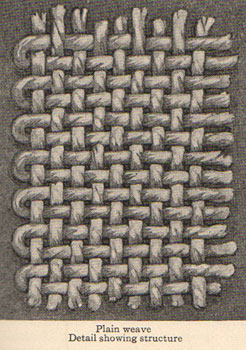
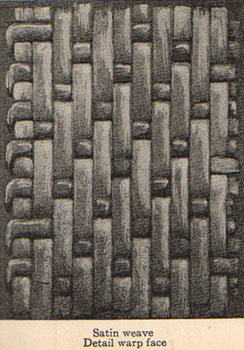
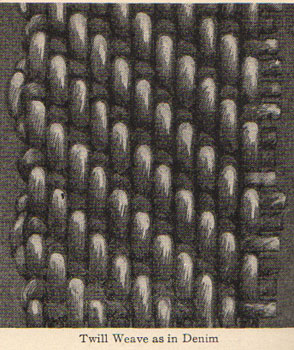
And a knit is not a weave at all. This is its basic structure:
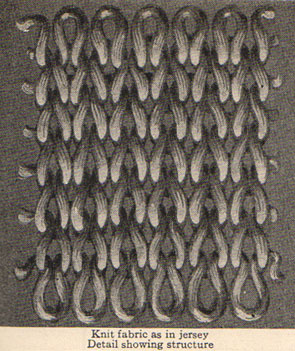
These are the basic weaves as more graphically illustrated in the Fairchild's Dictionary of Textiles:
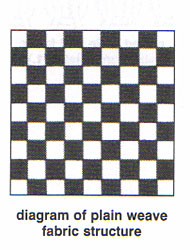
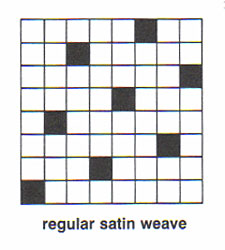
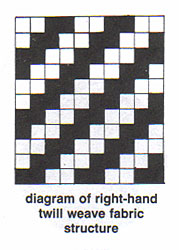
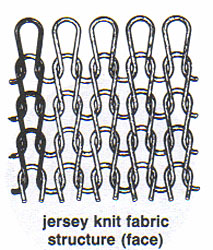
Next time: Some fabric definitions
How I am getting to know fabrics, part 2
Unfortunately, tagging around with an expert is unlikely to get you terribly far these days, unless you are lucky enough to be near a very fine fabric store, or if you are very lucky, a museum with a textile collection. The usual chain fabric stores are pretty slim on the variety of fabrics that were used for vintage clothing, or for better modern clothing.
A terrific resource then is a book of fabric swatches, and there is a series of three by Julie Parker: All About Silk: A Fabric Dictionary & Swatchbook (Fabric Reference Series, Volume 1), All About Cotton: A Fabric Dictionary & Swatchbook (Volume 2) and All About Wool: A Fabric Dictionary and Swatchbook (Volume 3). All, Rain City Publishing, Seattle, Washington, in multiple printings.
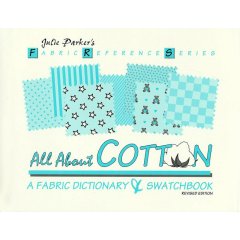

These three books have swatches of the most commonly found fabrics in pure silk, pure wool and pure cotton. There is also a lot of other information, written and printed in an easily digested, enjoyable way. Included is a rating of each fabric for sewing, fit, suggested styles, cost, wearability, suggested care and where to find. These books are pretty costly, about $25 to $35 each, either new or used, yet they are priceless resources for getting to know fabrics.
The only drawback that I can find is that these only take a very curious soul so far; if you want to know even more about fabrics, you will need to widen your net. What, for instance, of all the wonderful blends? What of synthetics and rayon?
I started my own swatch library, index cards on which I sewed swatches of fabrics when I was absolutely sure I had an example. The collection is pretty large by now. A great find was a 1950 swatch book of Fabrics For Fall (McGreevey, Werring & Howell Co.), 70 pages of good-sized pieces of fabric in a fine array of prints, weaves and fibers, all named. If you can find this sort of book at an antique shop, yard sale, or equivalent, I highly recommend you grab it!
Next time: Fabric basics.
How I am getting to know fabrics, part 1
It's just that fabric is about half appearance and half feel, and even the look is different in person than when on screen.
Before I get too far: I really have to know fabric better all the time. I sell vintage clothing, and my buyers and I want to know what a thing is made from. To know this is to tell someone whether she will be allergic, how to wash or clean the item, predict dye-ability. It is to know how fine it is, how long it will last, how the color will hold up. It helps make certain the vintage. It gives a better sense of how it will feel when worn. Buying clothing online is hard enough, and knowing all you can about the item is just smart.
Let me start with one colossal resource in the form of a heavy-duty dictionary, Fairchild's Dictionary of Textiles 7th Edition, Phyllis G. Tortora, editor, Robert S. Merkel, consulting editor, Fairchild Publications New York, 1996.

This thick volume, which runs about $47.00 new and not much less used (there are previous editions, which I've not seen, for less than half used) is a necessary compendium. There is so much more to each textile defined than expected, and often I get stuck reading and reading. Today it was muslin, and here is the whole definition to give you an idea of the depth of this book:
|
Thinking about today
Darkness cannot drive out darkness; only light can do that. Hate cannot drive out hate; only love can do that. -Martin Luther King Jr. |
I love my vintage clothing sources
Here is one such woman. Jacquelyn lives in the San Francisco area where she has been more or less all her life, still with her one and only true love. Her most glamorous clothing dates from the 40s, when she was young and had to dress well, as the hostess of an officer's club. However, she never stopped being a show-stopper, as her clothing attests.
Here is Jacquelyn with her mother Ailene, out shopping in the early 40s, as shot by a San Francisco paper: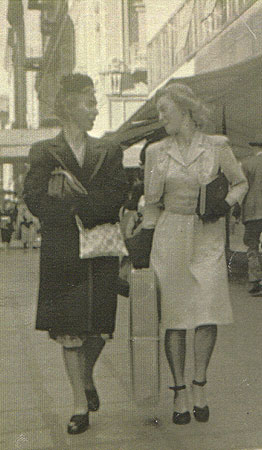
The woman's panache was and is incredible, and I believe it is in her temperament. Here are some (just some!) of her magnificent clothes. I felt very lucky to squeeze into just a few of her garments. She's about 5' 2" and has always been très petite. The only thing size XL is her smile!
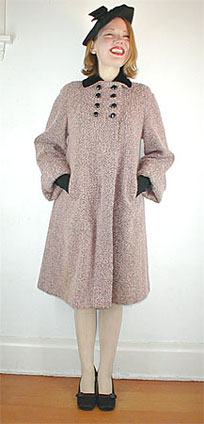
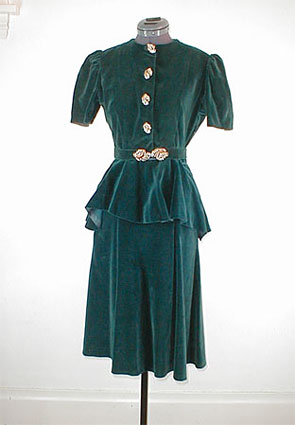
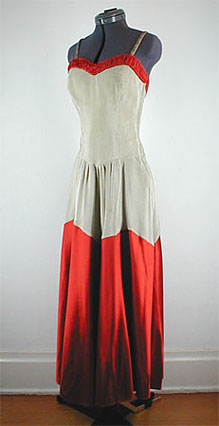
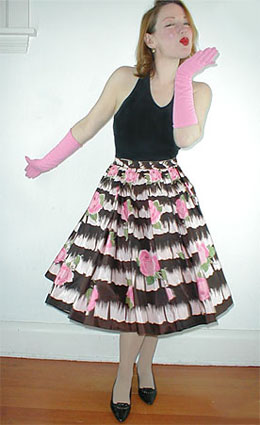
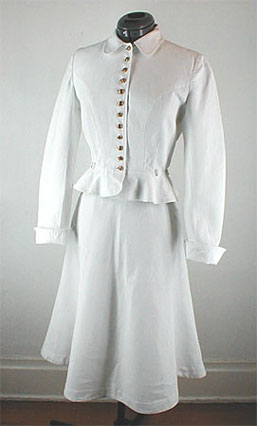
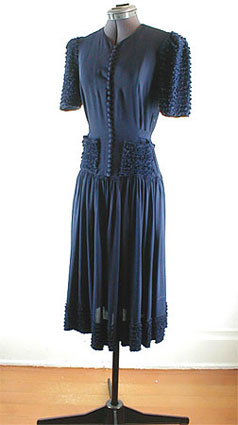
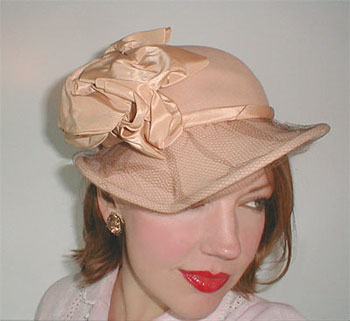
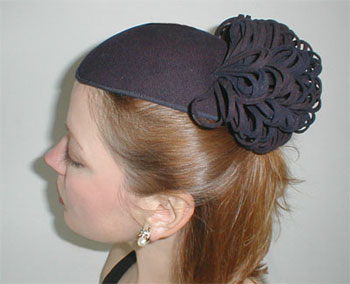
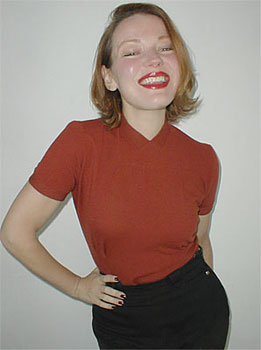
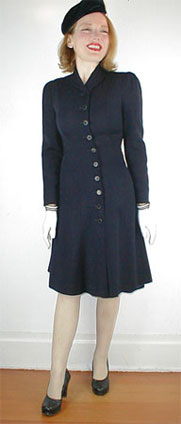
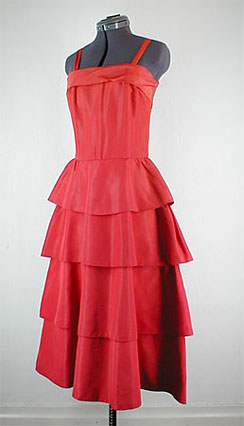
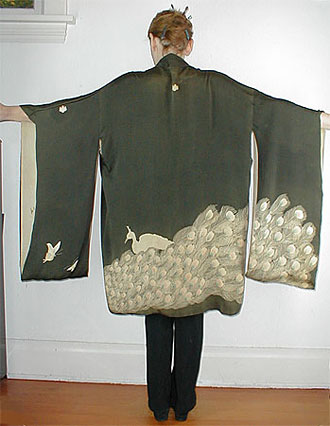
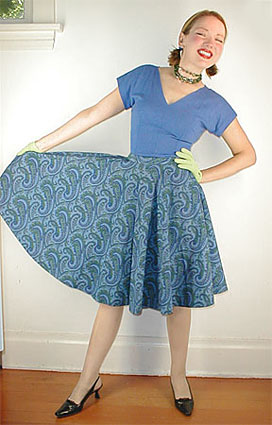
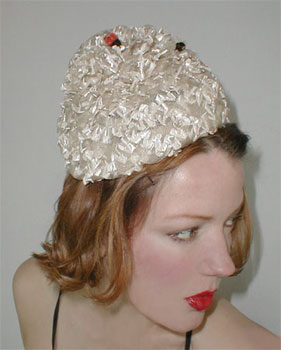
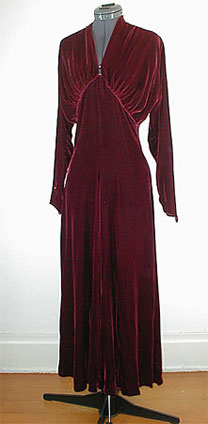
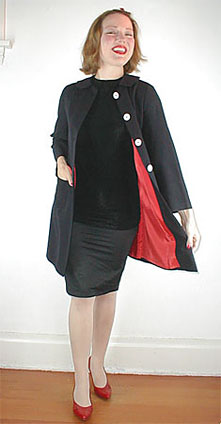
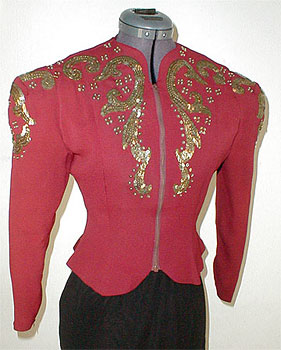
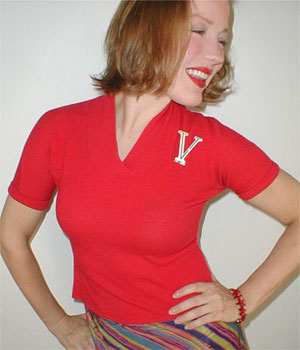
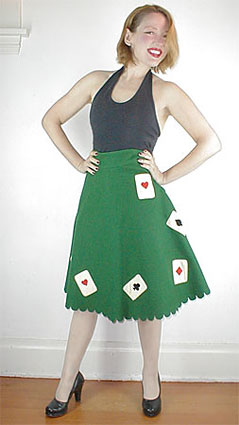
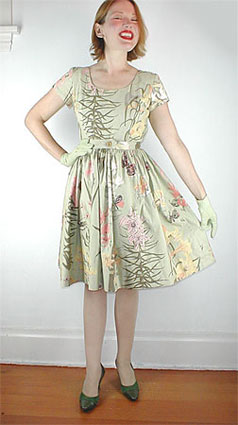
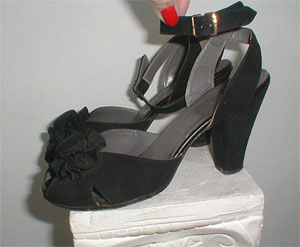
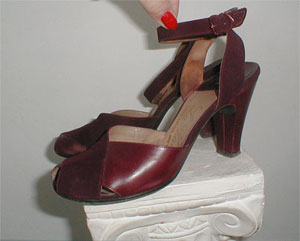
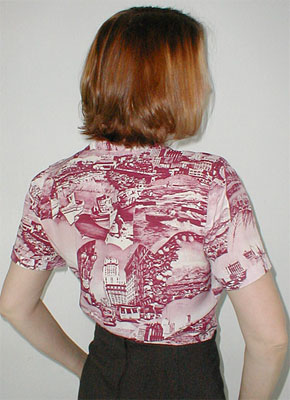
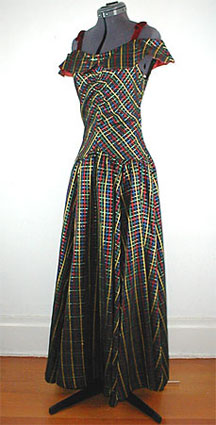
My odd collection
I think I love these because they came at a time when fashion was evolving. Particularly the late 60s ones seem to struggle to be relevant at a time when the previously mandatory slip was about to become uncool and outmoded. They are also fun, funny and undisclosed...a secret party!
I never go looking for these half slips, they just sort of fall in my path, like lucky pennies.










